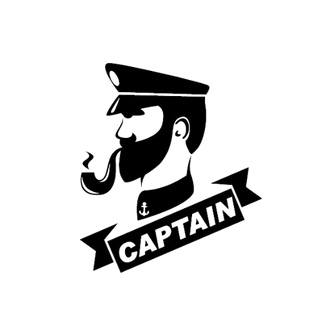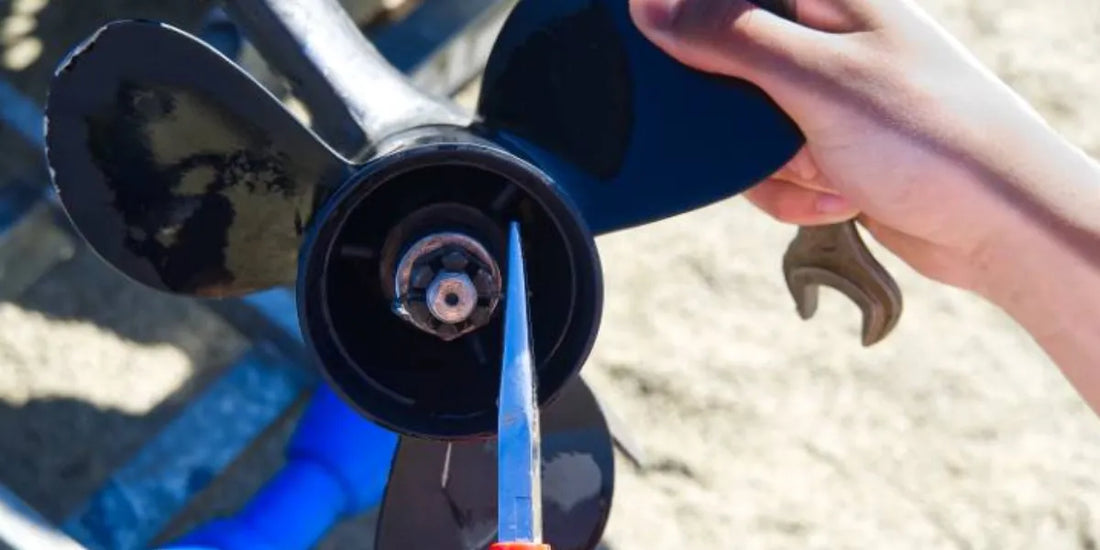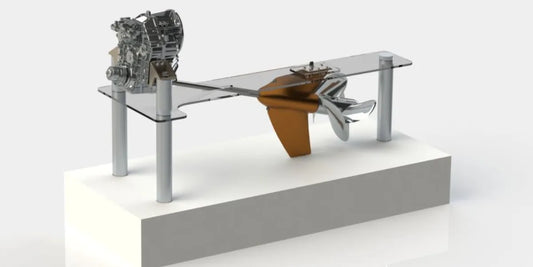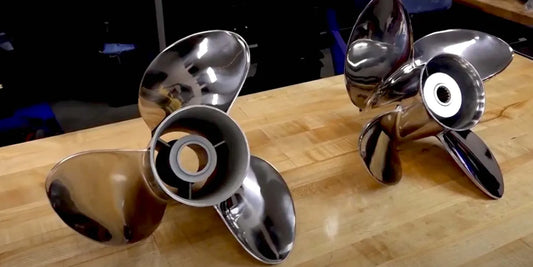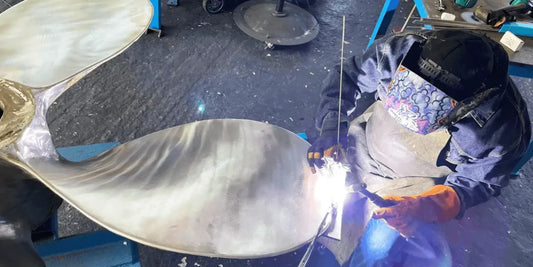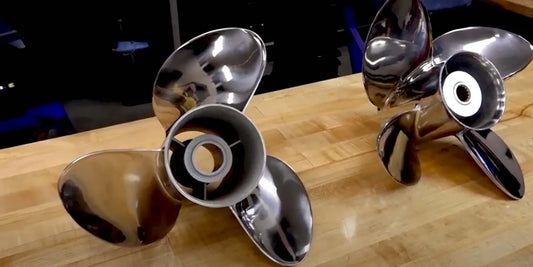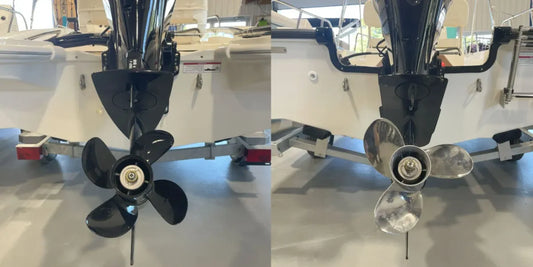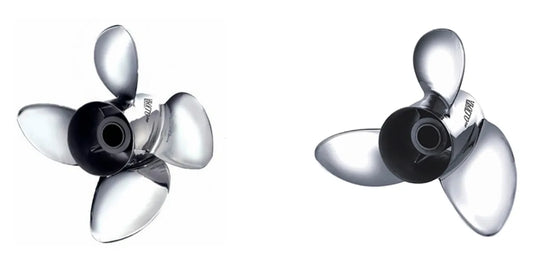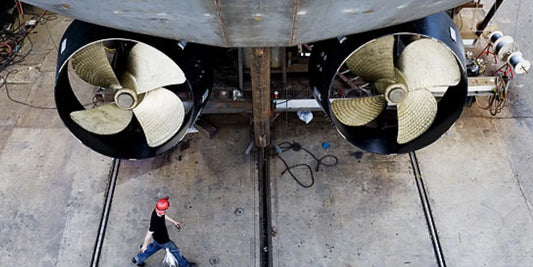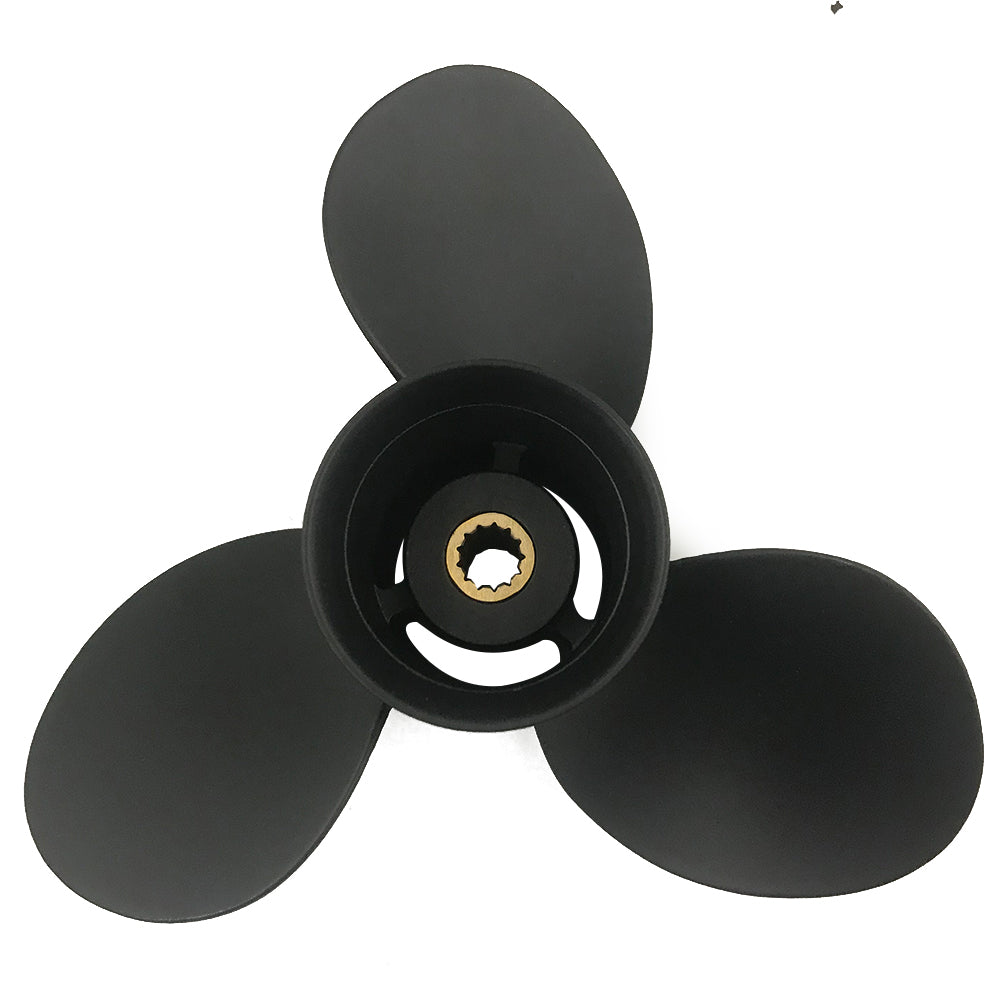A spun prop can ruin what could have been a perfect day on the water. One moment, things can be sailing smoothly; the next, you find the boat slowly losing power, though your engine is revving normally. Understanding what causes this common marine problem and how to avoid it can save you hours of downtime and tons of cash. This guide will take you through the complete mechanics of how a spun propeller hub works, how to spot warning signs, and how to keep your boat running smoothly. Whether you are a seasoned seaman or a layman keen on setup and maintenance, you will find sure tips to help you protect your investment while ensuring consistent performance on the water.
Introduction to Spun Props

What Is a Spun Prop?
A spun prop happens when the rubber hub in your propeller gives way and the propeller starts spinning independently of the prop shaft. This rubber hub acts like a shock absorber, absorbing shocks to protect the engine and lower unit from sudden impacts with underwater obstructions like logs, rocks, or sandbars.
If the hub wears off or fails, the prop will no longer hold onto the shaft. The engine would run normally at full RPM, but the boat would speed less and acceleration would worsen. In a manner of speaking, the power front from your machine has been reduced and the forward shore.
Common Symptoms of Spun Prop
If you can just notice and identify the warning signs in time, you can prevent the further damage to your propulsion system. Go for these symptoms:
Loss of thrust: Your boat just cannot reach its normal speeds despite the engine sounding normal. You may notice that either the top speed is severely reduced or your boat just has a hard time getting on plane.
High RPMs but Low Speed: The engine makes a very high-pitched sound at higher-than-usual RPMs. But they claim that the boat is moving very slowly or sluggishly through the water. The discrepancy we often hear between the engine and the boat performance is evidence of the prop slip.
Delayed Response: There's a noticeable delay when you throttle up, and the boat only accelerates after a moment. The prop seems to intermittently 'grab' rather than give smooth, even thrust.
Rubber Debris: Small pieces of black rubber appear around or in front of the propeller. This visible evidence points out that the hub is undergoing degradation.
Burning-Rubber Smell: From the propeller area, a typical burning-rubber smell is noticeable, especially at higher speeds.
Why the Proper Hub Is Important
The rubber hub has more functions than just connecting the propeller to the shaft. It is a sacrificial element designed to break first, preventing damage to expensive components. Charging an underwater object delivers a shock through the hub, which might save the lower unit, the drive shaft, and the engine from catastrophic failure.
An intact hub keeps constant contact between propeller and shaft for effective power transfer. Without this vital piece working correctly, nothing on your boat can perform as it should, not even the engine or the horsepower.
Causes of a Spun Prop

Understanding Prop Slip
Prop slip refers to the difference between the speed that a propeller should theoretically make an object undergo and the actual speed that is attained. Some slip is normal - between 5 and 20 percent depending on boat design and loading. Nevertheless, greater slip denotes trouble with a hub that is wearing out.
If the rubber hub were to degrade, it could not maintain a tight, firm contact with both the propeller housing and the shaft. Increase in the slip high enough for the propelling part to literally spin around the shaft rather than with it. This slip generation of heat causes acceleration of further deterioration of the hub, thus, creating a very damaging cycle.
Causes of a Spun Hub
Hub failure can be the result of or can be accelerated by:
Impact Damage: Underwater obstacles provide sudden, severe forces that tend to shear or compress the rubber hub beyond its design limitations. Even a single hit will gradually reduce the hub's efficiency.
Age and deterioration: Under continuous exposure to heat, sunlight, saltwater, and petroleum products, rubber compounds undergo gradual aging and deterioration. The old propeller may be affected at the hub level even in the absence of any overt impact damage.
Installation errors: Such improper installation might include failure to use sufficient torque on the prop nut, or a complete absence of hardware. Lacking requisite stresses then follow the hub, leading to its premature failure.
Overload: Continuous operation under heavy load requires hard towing of numerous water toys or overloading the boat well beyond its rated capacity, thereby subjecting the hub to stresses beyond its design limits.
Cavitation: When air bubbles appear around the propeller blades, they remain under unstable pressures. Cavitation can temporarily reduce the propeller's bite, imposing shock loads on the hub as it engages and disengages repeatedly.
Wrong propeller pitch. The wrong propeller pitch for your boat and engine will force the hub to work harder than it should. Constant stymying of the hub will accelerate wear.
In the performance of the propeller
The rubber hub creates an interference fit between the inner hub rotating with the shaft by means of splines and the outer propeller body. The rubber cushion absorbs torsional shock while maintaining positive engagement during normal operation.
High-quality hubs employ specially formulated rubber compounds designed to withstand marine environments and maintain the right balance between flexibility and grip. When this material fails, even if partly, the efficiency of the entire propulsion system suffers dramatically.
Preventative Measures for Spun Props

Regular Maintenance Tips
Constant inspection and maintenance will significantly improve the life of the hub!
Visual Inspection: check the propeller for apparent damage, bent blades, missing pieces, or visible hub deterioration before going out. Check if any clear separation between the hub and propeller body is visible.
Post-impact checks: Whenever you experience any strike or come across unusual vibration, immediately check your propeller. If everything seems fine with it, keep an eye on its performance over the next few trips.
Clean all the time: Remove any stuff that can get wrapped into the prop shaft, including fishing lines, weeds, or debris. These materials also induce drag and may end up in the hub area, causing damage.
Check hardware: Ensure the prop nut is still properly torqued and that all hardware, including any cotter pins or locking tabs, is present, secure, and undamaged.
Monitor Performance: Pay attention to your boat's typical performance characteristics. Note your usual cruising RPM and speed so that changes can be quickly noticed.
Choosing the Right Prop for Your Boat
Selecting the appropriate propeller will protect the hub from unnecessary stress:
Match pitch to application: Your engine manufacturer will usually give recommendations on what prop pitch you should use depending on your boat size, weight, and typical use. The engine should reach its peak RPM within its optimal operating range at wide-open throttle.
Consider the number of blades: For most purposes, three-bladed props are suitable; four-bladed props offer better bite and hole-shot performance but may cause more stress at the hub under certain conditions.
Material selection: Stainless steel props are much more rigid than aluminum, but on impact, they do not protect the hub as well because they tend not to deform. Aluminum props could very well act as a lifesaver for your hub by bending first when struck.
Hub design: Some manufacturers design performance hubs with rubber compounds or designs deemed suitable for high-stress applications. If you generally work in shallow, debris-filled water, these premium hubs may be a worthwhile investment.
How to Inspect Your Prop Hub
The propeller has to be removed for a complete hub inspection:
Remove the prop: After loosening the prop nut, slide the propeller off the prop shaft. Pay attention to the ease or difficulty while doing so; excessive resistance or unusual ease may be symptoms of trouble.
Look at the rubber: Look for cracks, chunks missing, discoloration, or any separation between the rubber and metal portions. Healthy new rubber should be consistently colored and slightly grained.
Check for signs of slippage: Shiny patches on the inner hub or propeller bore indicate the two components have been rubbing against each other. Check also for traces of rubber on the metal surfaces.
Check splines: Splines on the prop shaft and the inner hub should be sharp, well-defined, and curved. If splines are rounded off or damaged, it indicates severe slippage and requires immediate measures.
Try spinning: Remove the prop and turn the inner hub manually inside the propeller body. Some movement will occur, but a lot of free play means that the hub is a failure.
Repairing a Spun Prop

DIY Fixes for a Slipping Prop
For most boat owners, a spun hub is not really fixable. A rubber hub is manufactured with great precision as a complete part of the propeller assembly. Some marine shops can replace a prop hub, but they've got to have the proper tools and expertise to do so.
Your realistic DIY options are as follows:
Temporary solutions: If stranded, you can limp back home at very low speed, which may further damage the prop and, if possible, the lower unit.
Complete propeller replacement: For most boaters, the best option is to replace the entire propeller assembly; keep a spare prop aboard for emergencies.
Hub replacement service: Some prop shops can actually press out an old hub and press in a new one. This will cost less than replacing an entire prop but does require specialized equipment. You'll usually be looking at days or a week for turnaround time.
When to find a Professional
Consult a marine mechanic or a propeller specialist should you observe:
Performance issues are still persistent even after the prop replacement
A damaged prop shaft spline
A low unit vibration or strange noises
Bending of the prop shaft
Unsure of your prop selection for your boat
Balancing equipment is available with prop shops, which can ensure that the new or repaired propeller spins true. They can also detect problems that probably contributed to the incident that caused the hub to fail.
How Much Does It Cost to Fix a Spun Prop?
Prices vary depending on several factors:
Hub replacement: A hub professionally replaced often costs $75 to $150 in labor, plus the cost of the hub ($30 to $60), depending on the size and type of prop.
New Prop: Aluminum props are $150 to $400, while stainless steel ones are $300 to $800 or more, with prices rising with diameter, pitch, and blade count.
Associated Repairs: Shaft or lower-unit damage resulting from a spun hub would drive repair costs higher. Potential spline damage may require replacing the shaft, costing $200 to $500, and a lower unit rebuild can cost upwards of $1,000.
Emergency Service: Emergency service or on-site service is priced at premium rates.
A spare prop can be your insurance in case you get stranded and are charged for emergency service, or if you lose vacation days. Even a cheap aluminum one will do.
Final Thoughts on Prop Maintenance

A spun propeller hub is frustrating and preventable with a bit of care and attention. As a rubber part, the hub is the propeller's primary protection against impact damage and thus is subject to wear and tear, requiring replacement after a while.
Regular inspections spot problems early, so complete failure does not leave you stranded. Pick the suitable prop for the application, ensure it is installed correctly, and then consciously avoid operations in shallow or debris-laden waters with obstructions. Such basic acts indeed help in prolonging the life of the hub while protecting costlier components.
Keep proper records of propeller changes and any occasion of hub replacement. If failures occur at suspiciously frequent intervals, it might indicate a hidden problem—attitude toward weight, operating conditions, or even prop selection—that should be pursued further.
Most importantly, do not ignore those early warning signs. It is such a minor inconvenience to have to check your prop after some weird vibration or change in feeling when you are sitting offshore with a hub that is out of commission-it is pretty much insufferable! Stay vigilant with your prop and it will never cease producing performance for you for many seasons to come.
Reference Sources
Guide to Spun Props | Michigan Wheel Blog
This guide explains what a spun prop is and provides insights into its causes and prevention.
What Causes a Spun Prop Hub? | Boating Magazine
A detailed article discussing the symptoms and causes of a spun prop hub.
Characteristics of a Spun Prop Hub | The Hull Truth Forum
A forum thread where boating enthusiasts share their experiences and tips on diagnosing a spun prop.
How to Diagnose and Repair a Spun Outboard Motor | Marine Engine Digest
A step-by-step guide on diagnosing and repairing a spun propeller hub.
How to Fix a Spun Prop Hub: Permanent and Temporary Fixes | Propeller Propeller
A comprehensive guide covering both temporary and permanent solutions for fixing a spun prop hub.
Frequently Asked Questions (FAQs)
What Causes a Spun Prop and How to Check for Problems?
A spun prop can be the result of several causes, like an overstressed load on the shaft or maybe an over-tightened hard prop nut. At high RPM, the propeller might slip on the hub, especially if it has been subjected to hard impacts or poorly maintained. Periodic checks and tests by a local prop shop might identify issues before they become serious problems. Removing the prop for inspection might reveal whether the blades or the gear are damaged, or whether the inner sleeve is worn out. Proper installation and ensuring the prop is well-mounted may also cause the spinning to stop.
How to Extend the Life of Your Prop?
The most crucial maintenance needed for any prop intended to last beyond one season is cleaning and regular inspections. It includes cleaning and inspection to identify signs of wear and failure at an early stage. Inspect the prop nut and shaft for corrosion, especially if they are made of aluminum or stainless steel. Observing the speed and RPMs during test runs of your boat should also flag anything unusual, such as a spinner prop. When occasional problems arise, try taking the prop to a local shop for thorough inspection.
Steps to Take When Experiencing a Spun Prop While Running?
Should a spun prop happen on you during the run, it would be best to slow down immediately so as not to aggravate the damage. Inspect the prop nut to ensure it hasn't come loose, which is a common cause of such spinning. In case the problem still exists, then suffer the prop off and check the damages, which might give you a clue of the cause. Look for wear on the hub and blades, as heavy loading can wear them down. If the prop is indeed damaged, you will have to replace it or take it to a prop shop for repairs.
Can Water Affect the Performance of a Prop?
Different properties of water can significantly affect the operation of a propeller. For example, shallow-water operation places a heavy load on the prop, turning it against debris or obstacles. Other water conditions, such as waves or currents, could interfere with the prop's efficient operation. Considering the speed and RPMs of any given situation will certainly help solve any arising problems, as this knowledge is vital. Regular prop testing in different water conditions goes a long way in improving prop performance and durability.
What Are Common Signs of a Spun Prop?
Uncommon signs of a spun prop are a drastic sudden decrease in speed or RPMs while running. You may also hear odd sounds from the prop or feel vibrations in the steering. Another indication of a spun prop is when the boat has trouble accelerating, perhaps because the blades are slipping on the hub. If you have recently hit an obstacle or had a hard landing, that indeed worsens matters. With regular inspections and checks, these concerns can be caught early, before they snowball into bigger, more expensive repairs.
Can a Damaged Hub Cause a Spun Prop?
Yes, the prop can be spun due to a damaged hub. The hub connects the propeller with the shaft, so if worn out or damaged, the shaft will slip from the hub. This slippage is very typical of an aluminum or plastic prop. Thus, if running, the prop's turning action will be free because it has no firm grip on the shaft, which will cause performance issues. Preventing this kind of problem: sometimes the hub needs to be checked for wear.
How to Test for a Spun Prop?
Testing a spun propeller involves a few simple procedures. First, remove the prop and inspect the blades and hub for any apparent damage. Then attach the prop and test-run it at various speeds, watching for unusual vibration and drops in RPMs. The better the propulsion acceleration, the less will be the slippage; if it cannot accelerate properly, this is a strong indication of this condition occurring. If you find yourself suspecting that the prop may have spun, it would sound pretty reasonable to take it by the local prop shop for an in-depth inspection and ultimate replacement.
